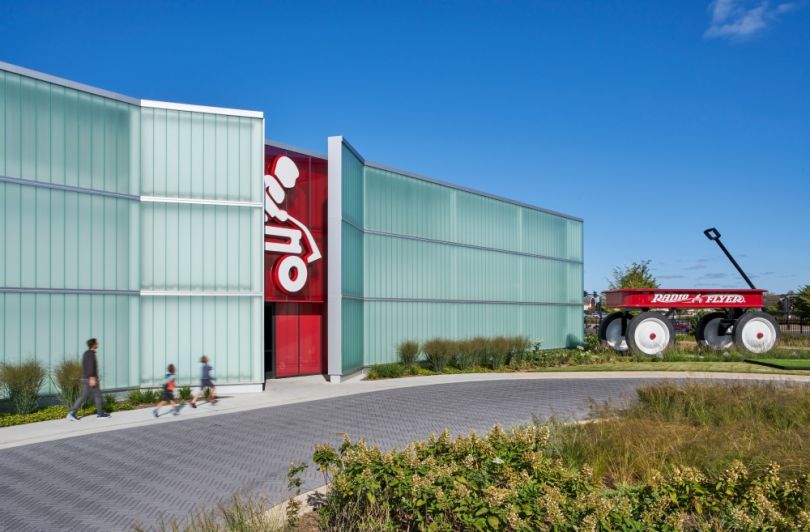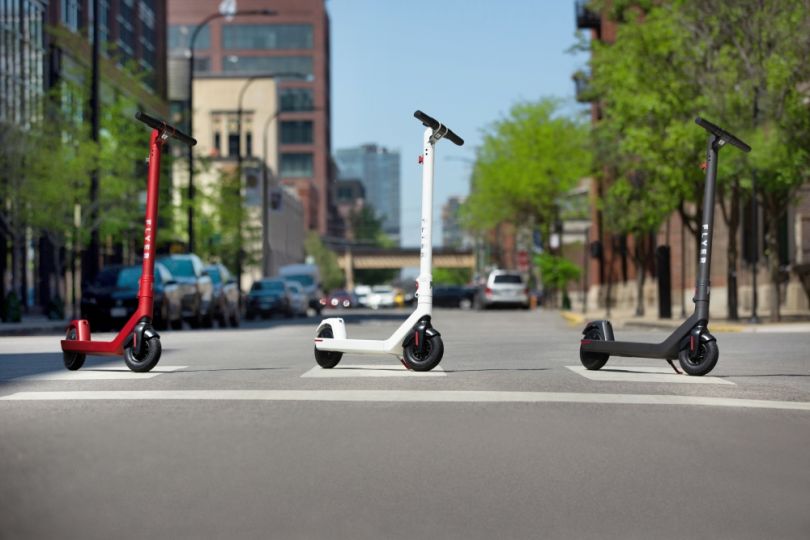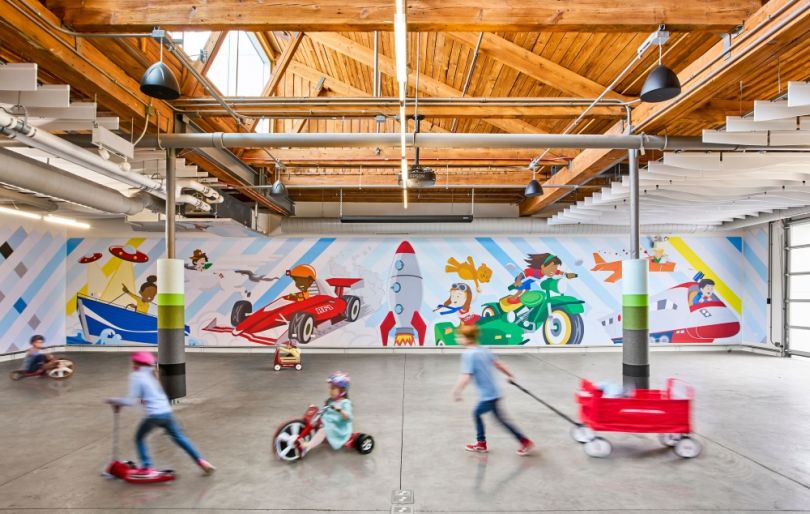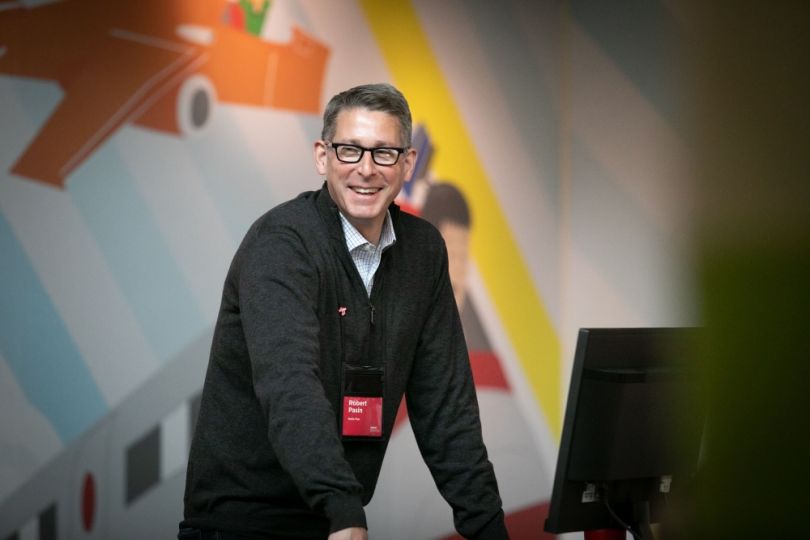The Radio Flyer corporate headquarters sits on the Northwest edge of Chicago, about a half hour’s drive from downtown, as it has for the past century. Today, a 15,000-pound red wagon stands guard on the front lawn of the nine-acre lot, which is hemmed in by rows of shrubs and a black steel fence. Portions of the main building’s frosted channel-glass facade come to an angle on either side of the front entrance, resembling a giant set of cracked-open double doors — a declaration to passersby that something worth peeking at is going on inside.
It was still spring when I first spoke with the company, making it too early in the vaccination rollout to walk through the pearly threshold in person — despite it being just a few neighborhoods over from my apartment. Instead I logged onto Zoom, where I connected with Robert Pasin, Radio Flyer’s chief executive officer, and talked to him about what he and his team have been up to over there.

From the reverence with which Pasin talks about Radio Flyer’s history, you get the sense that he sees himself as the steward of the little red wagon’s legacy. That said, one of the biggest things his team is working on right now is to reinvent the brand by keeping up with recent trends in micro-mobility — a product category that has surged in popularity in recent years largely thanks to tech startups like Bird, Lime, Lyft and Uber.
Earlier this summer, Radio Flyer announced the release of its Flyer line, which includes a $600 electric scooter and two electric bike options, one model retailing for $1,700, and a cargo bike priced at $2,000 that’s beefy enough to haul a couple of kids on the back.
With its Flyer line, the company is making its first official foray into an adult-oriented category, betting that the sustainable transportation trend and the rise of electric scooters — projected by some to be a nearly $600 million market by 2025 — will continue upward as the world recovers from the pandemic.
“For a lot of people who haven’t seen our product line in recent years, it may seem like a pretty big leap,” Pasin said.
But he sees the Flyer line as a logical extension, not a deviation from the company’s trajectory.

Despite being largely known as the company that sells toy wagons, Radio Flyer has, for years, extended its product line to capture a greater share of the market and stretch its offerings as far as its core identity will allow.
For example, the company has partnered with Tesla to produce kid-sized Model S cars, powered by lithium-ion batteries. And its e-commerce store allows online shoppers to customize their own vehicles, similar to how Nike ID lets sneakerheads design shoes according to their tastes.
“We want to make sure that any product we come out with, people will look at it and say, Oh, wow, that’s new for Radio Flyer, but I get it, that makes sense,” Pasin said.
Inventing the Wheel
Pasin’s grandfather, Antonio, first set eyes on the Statue of Liberty in April of 1914. The 16-year-old cabinet-maker’s son from Venice, Italy, had just docked in New York after having crossed the Atlantic crammed in third-class steerage aboard a ship named Cleveland, which disembarked from Genoa, Italy, two weeks earlier. Apparently, the statue left a deep enough impression on Antonio that, when it came time to name his first toy wagon line, he chose to call it the Liberty Coaster.
But before he built his first wagon, Antonio had to board a train for Chicago, where he worked a string of jobs — which included hauling water for a crew of sewer diggers — until he scraped together enough savings to open his own workshop.
There, he built and sold handmade furniture, wine presses, phonographs, wooden tricycles and, eventually, little wooden wagons for kids.
Soon, he was selling these Liberty Coaster wagons about as fast as he could build them, and they became the centerpiece of his business.
Hoping to scale production and outpace his competitors, Antonio switched from wooden wagons to all-steel ones in the mid-1920s. He took out a line of credit, bought the car factory next door and implemented the mass-production techniques of Detroit’s burgeoning auto industry, modeling his operations after the famous Model T assembly lines pioneered by Henry Ford. By the 1930s, Antonio’s process was so operationally efficient that his team of 140 workers could stamp out 1,500 of them each day.
Along the way, Antonio had re-named his business the Radio Steel & Manufacturing Company, and gave his freshly designed flagship wagon a new name too: Radio Flyer. The name paid homage to what was, in his eyes, two of the world’s all-time greatest innovations: the radio and the airplane.
Antonio’s biggest bet came in 1933, when he took out a $30,000 loan for a Radio Flyer exhibit at the Chicago World’s Fair. He wanted to make a splash on the world stage and catapult Radio Flyer to iconic brand status. He even commissioned famous industrial designer Alfonso Iannelli to construct a 50-foot-tall sculpture of a boy riding a Radio Flyer wagon.
The bet paid off: Forty-eight million people visited the World’s Fair that year, and 120,000 of them bought miniature Radio Flyer wagon souvenirs that would not only cover Antonio’s debts, but serve as tactile reminders to fairgoers of the giant bright red wagon that had captured their imaginations.
From the 1940s to the 1960s (after which point Antonio’s son, Mario, took over the business) Radio Flyer sales quadrupled. It became a staple of middle-class homes, a symbol of heartland Americana: green lawn, white picket fence, little red wagon.
Kicking the Tires
The company Pasin inherited in 1997 was stuck in neutral. For years it had been puttering along, running on the fumes of its past achievements.
Determined to shake things up, Pasin’s first order of business was to talk to customers. He wanted to know about their needs, wants and habits, how kids played, how parents transported their families. He hired market research firms and dispatched product designers to go out into the field — zoos, ballparks, playgrounds — and observe.
He eventually went so far as to install a play lab in Radio Flyer’s headquarters, complete with a test track sidewalk, on which kids rode around in wagons and parents pretzeled strollers into the trunks of their cars, as video cameras captured any observation that might be useful for the company to fold back into its product development.

It was by soliciting feedback and paying close attention to customers that Radio Flyer found inspiration for some of its now-best-selling products and most-cherished features.
“We do a ton of ethnographic research,” Pasin told me. “That’s the key ... really staying close to consumers, and solving their problems.”
Early in his tenure, Pasin also reduced the company headcount by nearly half (the “culture was too far gone” at that point, he told Inc.) and outsourced all manufacturing to China, with the aim of weeding out any distractions that could risk pulling the company’s attention away from where Pasin thought it should be: on designing high-quality products that every family wants.
Now, Radio Flyer’s annual revenue exceeds $100 million.
Living in the Tension
Back on the Zoom call, Pasin rehearsed a line he had written in his book on the company’s history: “The first thing people do when they hear Radio Flyer is smile, and the second thing they do is tell a story.”
The statement signals a tricky situation in which Radio Flyer finds itself. Being a nostalgic legacy brand is like wielding a double-edged sword. It can make you dangerous, but if you aren’t careful, it can cost you a limb.
“That’s something we talk about a lot,” Pasin said. “There’s definitely an inherent tension between the nostalgic part of our brand and trying to remain current and relevant.”
Indeed, when Pasin first took the helm at Radio Flyer, he had a complicated view of nostalgia. He was “really paranoid about becoming a relic,” he told his alma mater. But he later came to realize he could harness the power of the sentimental feelings people attached to the brand without letting it get in the way of creating new products. Nostalgia didn’t have to be a ceiling, it could be a flywheel.
“There’s definitely an inherent tension between the nostalgic part of our brand and trying to remain current and relevant.”
“I think actually that tension is where we’ve had some of our greatest successes and unlocked some of our greatest creativity,” he said.
Having a “place in people’s hearts,” as Pasin put it, is only the first half of the equation. The second half, he said, is wowing them with new products, delighting them with features that anticipate their needs.
“I think that’s a very potent combination, when you have that lifetime relationship with the consumer,” he said, “and then they can see that you’re not just selling the same old thing.”
Pasin explained that the constellation of Radio Flyer products is meant to provide something for every family, each step of the way. It’s what generates repeat business.
Most families that buy their first Radio Flyer wagons, he said, do so before a child’s first birthday. Then, when it comes time to graduate to a tricycle, or a stroller, or a carrier bike, parents can easily dip back into the product line. Eventually, when the kids are old enough, the logic goes, they’ll have enough affinity for the brand that they’ll want an electric scooter or bike from Radio Flyer too.

Taking Flight
As Radio Flyer treks into new territory, will the original little red wagon remain the touchstone, the home base from which the brand can’t stray too far away? Is anything with wheels fair game for the brand?
“Anything around outdoor active play,” Pasin said, proceeding to rattle off a list of unwheeled Radio Flyer products, like bounce houses and foam blocks. “The sun in your face, the wind in your hair: those are the things that people say to us they remember about Radio Flyer.”
At the same time, Pasin is very cautious about not going so wide as to erode the brand equity it took a century to build.
“Those constraints are what make a brand a brand, versus just being into everything and meaning nothing to people,” he said. “We don’t want to dilute our brand.”
Pasin mentioned Lego — another toy company owned by a family, members of which he told me he’s met — as a brand that’s faced similar challenges but made all the right moves.
“The Lego brick, it doesn’t get much simpler than that,” and yet it “unleashes people’s imaginations.”
Indeed, Lego has moved way past its flagship toy line, extending into parks, movies and video games — far beyond what one would reasonably anticipate for connectable pieces of plastic.
It’s unclear if Radio Flyer has plans to match Lego’s level of ambition (although it’s worth noting that, in 2015, Pasin produced an animated short film about Radio Flyer, and won a Daytime Emmy for it).
For now, though, Pasin and his team are focused on the long game — thinking generationally rather than quarterly, launching new products and refining old ones, emphasizing innovation and customer experience above all else.
“If we keep doing that, and doing it really well,” he said, “I feel like we’re pretty much unstoppable.”




